-Artocarpus altilis: Breadfruit
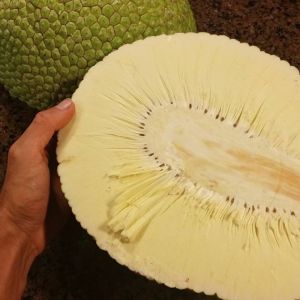
I think of breadfruit as roughly equivalent to a potato that grows on a tree. The fruit is not well suited to eating as a fresh/raw food, but cooked it is an outstanding starchy food that can be used in many of the same ways as potatoes: roasted, fried, mashed, etc.
The breadfruit tree is a tremendously productive food plant, with some of the highest yields per hectare of any starchy crop.
Breadfruit grows throughout the lowland areas of the wet tropics. It is cold sensitive, and does not like to even get close to the freezing point. In Florida, for many years breadfruit trees were restricted to the Keys, the island chain off the southern part of the peninsula where winter low temperatures are buffered by the surrounding water. In recent years, a string of mild winters has enabled breadfruit trees to produce fruit in the southeastern part of the peninsula.
Breadfruit is native to Southeast Asia. It was one of the “canoe plants” which the Polynesians carried with them as they colonized islands across the Pacific.
Some forms of breadfruit are seedless; some have seeds which are edible when cooked, resembling chestnuts in flavor and texture.
-Artocarpus anisophyllus: Entawak or Mentawa
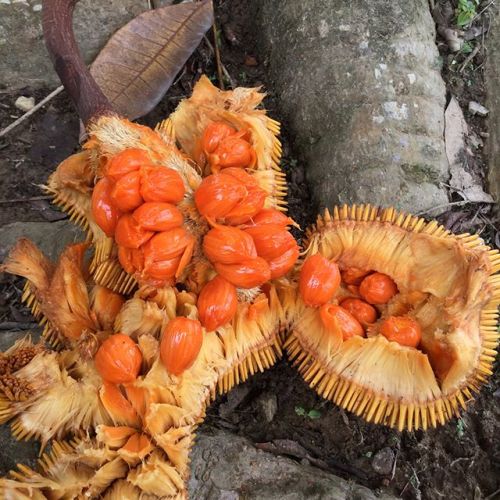
Entawak fruits are smaller than those of many fruits in the Artocarpus genus, only about 8-11cm (3-4 inches) in diameter, with a spiky shell surrounding bulbs of intensely red-colored flesh around the seeds. People report the flavor is excellent, very intense and sweet, tasting a bit like baked pumpkin with wheatgrass juice.
Native to Borneo, Sumatra, and peninsular Malaysia. Common names are bintawak, bintawa, entawak, and mentawa. Extremely rare even where it does grow – Rare fruit hunter Fit Shortie reported that in Sekadau, Borneo, she and her partner Simon asked every durian seller if they knew of this fruit, and finally one of them said he knew of a tree 20 kilometers away, deeper into the jungle. They traveled the distance to the reported location, where they met a ten-year-old who led them to the tree, climbed the 30 meter (90 foot) tall tree and cut fruits for them. She said the taste was “better than any terap, intensely sweet, you can literally taste the colour.”
Very tropical, only grows in the lowland equatorial tropics, cannot survive temperatures below 50 F (10C).
-Artocarpus heterophilus/integrifolia: Jackfruit
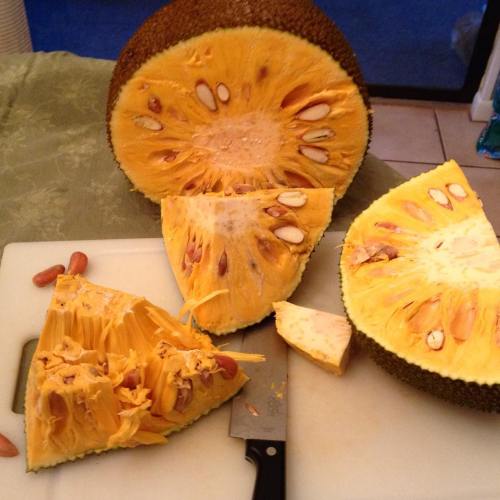
Jackfruit is one of my favorite fruits, with an aroma and flavor that are just crazy-tropical, an amazing symphony of aromas and flavors.
Jackfruit is the world’s largest fruit that grows on a tree. A single jackfruit can weigh as much as 35 kilograms (80 pounds). Since tree branches might break under the weight of such a load, jackfruits often grow right out of the trunk of the tree.
The structure of a jackfruit consists of fruity flesh and seeds surrounding an inedible central core that runs from the stem up through the center of the fruit. The fruity flesh occurs as a jacket of flesh, or bulb, surrounding each seed – those jackets of flesh are the edible part. There are also stringy fibrous tissues running between the jackets of flesh, collectively called the “rag”. In some varieties, the rag is stringy and inedible, in others it’s sweet, fleshy, and delicious.
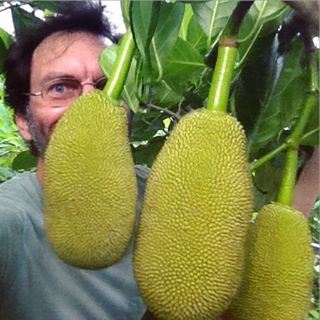
Jackfruits can be eaten in two ways: immature or mature. Immature jackfruits are cut from the tree before they have started developing any sweetness or fruity flavors. At this stage, they don’t have a lot of flavor, but they have a pleasant texture, and are used as a vegetable, making a good vegan meat substitute for cooking in tacos and “pulled pork” sandwiches. But left on the tree to maturity, jackfruits develop sweetness and an intense of flavors, making them one of the world’s top dessert fruits. In recent years, immature jackfruit used as a vegetable has exploded in popularity. This is a great development, making use of an outstanding sustainable tree crop in healthful, plant-based foods. But one side effect is that millions of people now think that jackfruit is just that stuff used as a sandwich filling, and they don’t realize the other form of jackfruit exists: the mature fruit, an amazing fruity delicacy.
Jackfruit trees vary considerably in the flavors of fruit they produce. One jackfruit tree I know of in South Florida has fruits which taste like an orange creamsicle, combining jackfruit’s usual symphony of tropical aromas & flavors with a powerful citrusy-orange taste, balanced on top of a rich, cream-like texture. This is one of those jackfruits where not only are the jackets of flesh around the seeds deliciously edible, but so is the rag, the strings of flesh between those jackets of flesh. (Although the rag is still kind of fibrous, and I spit out the fibrous bits once I’ve sucked all the wonderful orange-cream flesh off them.)
It’s possible to make a fantastic jackfruit-flavored soft-serve ice cream, from nothing but jackfruit. Just freeze the jackfruit segments, and run them through a Champion juicer. That machine gives the resulting “nice cream” the most amazingly rich, creamy mouth-feel, featuring the full jackfruit flavor explosion with no added oils at all. This technique also works great with mango, banana, and mamey sapote, to make dairy-free, oil-free, soft-serve tropical fruit nice cream.
Jackfruit trees grow in hot, humid tropical climates, into wet areas of the subtropics. When mature, they can handle light frost with minimal damage. They grow and fruit well in South Florida.
-Artocarpus hypargyraeus: Kwai Muk
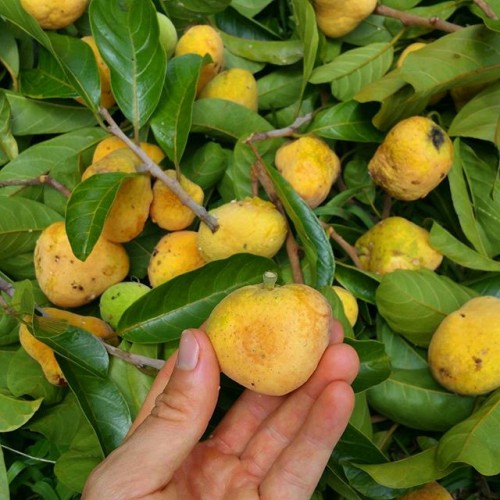
Kwai muk is one of the smaller-fruited members of the Artocarpus genus, with fruits about 1 to inches (2.5 – 5 cm) in diameter.
Kwai muk fruits reportedly vary considerably from one tree to another, with some trees producing excellent fruit. I’ve only had them from one tree, which had a creamy flavor and a pleasant, strawberry-like flavor.
I’ve heard other people report detecting flavors in kwai muk that remind them of mango, apricot, jackfruit, grapefuit, fig, and guava.
The tree is somewhat smaller than many of its Artocarpus cousins, reaching about 15-25 feet (5 – 8 m) tall. The tree reportedly can handle light frosts, unlike many of the members of this genus, which don’t like temperatures that get anywhere close to freezing.
-Artocarpus integer: Champedak/Cempedak/Tibadak
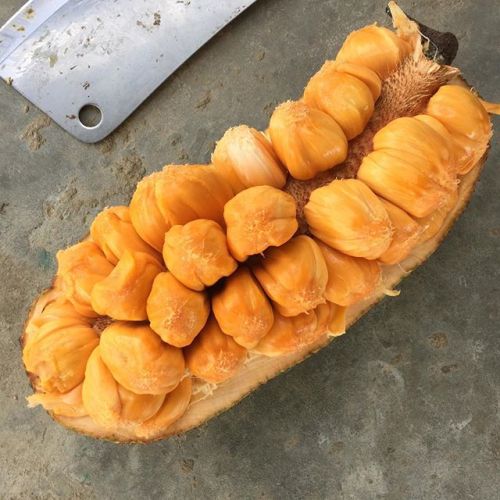
Good champedak is rated among the world’s best fruits, according to people who have tasted this rare fruit, which is native to Southeast Asia. Apparently there are mediocre varieties of champedak out there, but people report that the best ones have durian-like flavors and aromas, a creamy texture, and are super-sweet. Some of the flavors people report detecting are orange sherbet, bubble gum and salted caramel.
Champedak is a cousin of jackfruit with roughly the same fruit structure – a central core, surrounded by seeds encased in jackets of sweet edible flesh, with a rough-skinned rind surrounding the whole thing. The rind appears more loosely attached than in jackfruit, and people usually peel off the rind to expose the edible portion within.
Rare fruit hunter Fit Shortie rates chempedak as her favorite sweet fruit in the world. It’s lots of fun reading her super-enthusiastic posts about this fruit. Here are a few of her quotes about champedak (also spelled cempedak):
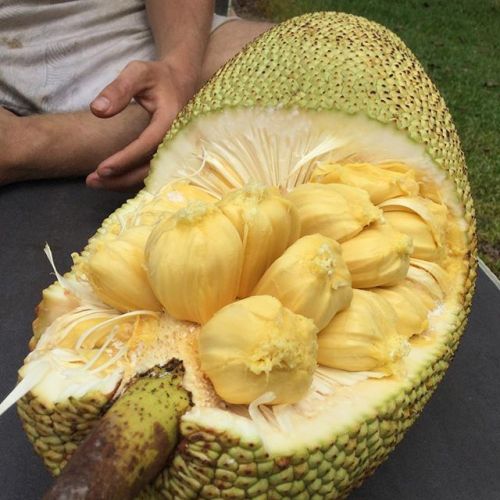
Champajack is a hybrid between two great fruits – champedak (Artocarpus integer) and jackfruit (Artocarpus heterophylla). Taste reportedly is phenomenal. Photo by Fit Shortie.
“The cempedak is my number one sweet fruit. Salted caramel ice cream flavor…. They are beyond durian. Insane quality of fruit. It was so SWEET the aftertaste of each pod, the caramel sugar edge would just burn into our tastebuds, while the orange goo would drip from our lips. We were just sitting there… shaking our heads in disbelief, thinking this is just too sweet. How does this ‘best fruit in the world’ taste like? This is how I explain it – if durian and jackfruit had a baby – it would be cempedak.”
There is a lot of variation from tree to tree among champedaks. Some have flesh that’s whitish-yellow, while in some the flesh is closer to orange in color. Champedak trees are more cold-sensitive than jackfruit trees, thriving only in rainy equatorial climates.
-Artocarpus odoratissumus: Marang/Tarap

This is another big Artocarpus fruit packed with sweet fruity-tasting pods of flesh around the seeds. The best cultivars reportedly taste like vanilla lime marshmallows with a hint of tangerine, and a soft texture that dissolves on the tongue. Other flavors people report are banana, melon, and cinnamon.
Called tarap in Borneo, marang in the Philippines, this is a powerfully scented fruit. Some forms smell pleasant (at least to exotic fruit lovers), while in other forms of marang the smell is unpleasant, reminding people of the smell of diesel fuel.
Rare fruit hunter Fit Shortie gives a first-hand report on this species: “Not all marangs are the same. Some have big pods, some have hundreds of narrow pods, some have underdeveloped pods in the mix. Some are packed with pods, some are not. The shape & volume does not seem to affect the taste – we’ve had great ones no matter the structure. Their taste can vary between uber-sweet vanilla marshmallow and sweet, fresh limey marshmallows, I love the limey ones. The smell of the marang is way more intense than durian for me right now, I can smell a marang hidden at the bottom of somebody’s truck from the other end of the fruit market. I can smell a marang tree while we drive by on the motorbike at full speed.”
Marang is an ultra-tropical tree, thriving only in rainy lowland areas near the equator. It doesn’t like temperatures that dip anywhere close to frost. Reportedly the best forms of this species grow on the island of Mindanao, in the southern Philippines.
-Artocarpus sericicarpus: Pedalai
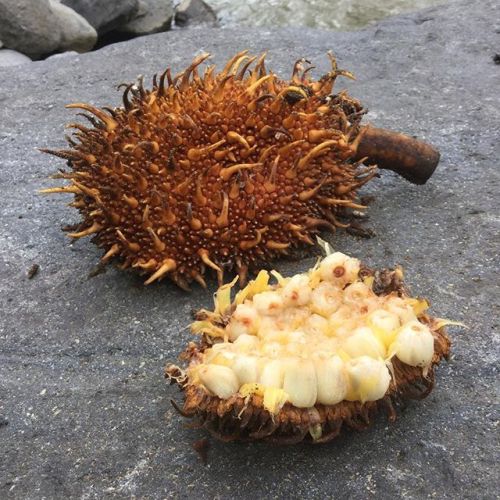
Pedalai (Artocarpus sericicarpus) has been described as “the Holy Grail of Borneo fruits” for its outstanding eating qualities. Photo by Fit Shortie.
Pedalai (Artocarpus sericicarpus) has been described as “the Holy Grail of Borneo fruits” for its outstanding eating qualities. The Rare Fruit Council of Australia reports that the flavor of pedalai is superior even to that of marang (Artocarpus odoratissimus), and they recommend this fruit tree for widespread planting in the tropics. One report says pedalai has a flavor reminiscent of “overcooked sweet pumpkin with fruity juiciness”, another describes it as having a “creamy vanilla flavor’.
Pedalai is another Artocarpus with a bumpy, knobby rind, underneath which jackets of sweet flesh surround the seeds. Fruits are around 15 cm (6 inches) in diameter, turning orange when ripe, and sometimes with fibrous projections from the rind that can give it the appearance of a giant rambutan fruit. Unlike marang, the fruits have little aroma. The seeds of pedalai, like other Artocarpus, are edible when cooked – reportedly after a brief frying in oil, they taste like peanuts.
-Ficus carica: Common Fig

Fresh figs have a wonderful sweet fruity flavor, and a melting soft texture. In the US, many people have only eating figs dried, or as the pasty filling in a Fig Newton, and have never experienced the lusciousness of the fruit in its fresh form. If you live in a climate zone where fig trees grow, try to find a place where you can eat them straight off the tree (like I’m doing in this pic), or get some at a farmers market. If you’re outside of fig country, watch your produce department for imported figs. Even if you’re in an area with icy cold winters, there’s a chance someone might have a fig tree around and will share some fresh fruits with you. The Italian gardeners of New York and Chicago are legendary for the heroic efforts they go through to protect their fig trees, even burying the trees in a trench each winter and raising them out of the ground each spring. (Yes, fresh figs are that good.) If you harvest figs off the tree, be aware that the best figs can sometimes look to a novice like they’re a little past-peak. Slight cracks develop on the skin of some varieties, and the fruit droops slightly – those are the signs that a fig is at the peak of delicious ripeness.
Figs are loaded with health-promoting antioxidants. And here’s something really interesting: researchers who tested six different varieties of fig confirmed something I’d suspected: the darker varieties of fig have higher levels of antioxidants. “Color appearance of fig extract correlated well with total polyphenols, flavonoids, anthocyanins, and antioxidant capacity. Extracts of darker varieties showed higher contents of phytochemicals compared to lighter colored varieties.” I’ve been trying to collect dark-purple fruited varieties of fig, looks like I’m on the right track with that. One of the main antioxidants in figs is antirrhinin, the highly-touted nutrient that’s also present in acai and black currants.
Figs are more than just delicious – they may have been the first crop humans ever cultivated. Archaeologists have discovered the remains of an apparently domesticated form of fig at a site from 9300 BC. That’s a thousand years before the domestication of wheat, barley, and peas, which are usually considered humans’ first crops.
Fig trees grow best in Mediterranean climate zones, but can produce at least some fruit in the subtropics, tropics, and even the warmer parts of warm temperate zones.
-Morus spp.: Mulberries

Mulberries are sweet and delicious, and this is fruit with one of the widest distributions of any that I know of: there are forms of mulberries that will grow in climates all the way from the equatorial tropics to regions with snowy, cold winters.
Mulberries are packed with healthful anthocyanin pigments, which reportedly help prevent cancer and inflammation. At least one study found that mulberry anthocyanin extracts prevented the development of diabetes in animals prone to the disease.
Finding very early and late varieties is something where a group effort can benefit us all, so we can all enjoy the longest possible season of anthocyanin-packed mulberries. Do you know of any especially early or late-fruiting mulberry trees?
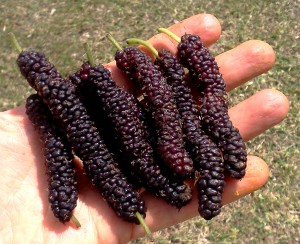
“Himalayan” is the best-tasting mulberry I’ve ever eaten (and I’ve eaten a lot of really tasty mulberries). The berries are three inches (7.5cm) long – the same dimensions as my pinky finger.
In the US, many people have never eaten a mulberry, and only know this fruit from a nursery rhyme about a ‘mulberry bush’. Which is a crazy situation, because this is a delicious, productive fruit tree (not a bush) that’s super-easy to grow over most of the US. Kids and adults love eating these fruits.
Back in the spring of 2004, my friends and I found a mulberry tree growing in Gainesville, loaded with an incredibly abundant crop of big, flavorful berries. The tree made similar crops in subsequent years, and was clearly a superior fruiting variety. We started propagating plants by rooting cuttings from this tree, and we distributed the young mulberry trees at farmers markets and festivals through our volunteer group, the Edible Plant Project (along with many other food-producing plants). The original mulberry tree was growing on NW Sixth Street in Gainesville, so we named the variety “Sixth Street” mulberry. As a result of our efforts, there are now many hundreds, possibly over a thousand, “Sixth Street” mulberry trees fruiting all over the southeastern United States every spring. That’s how it works: find superior varieties of fruit trees, propagate them, and distribute.
Other tree crops in the Moracaeae:
-Brosium alicastrum, Mayan breadnut
-Brosimum galactodendron, cow tree
-Maclura tricuspidata, che
-Treculia africana: African Breadnut